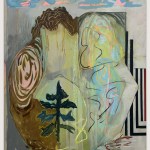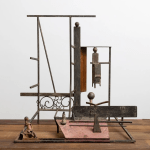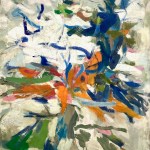
Contributed by Sharon Butler / Coinciding with their individual solo exhibitions at Anders Wahlstedt Fine Art and Gold Montclair that focus on sports imagery and content, I invited Two Coats contributor Zach Seeger to talk to Terry Rosenberg about his practice and current exhibition. This is the intriguing exchange that took place.


April 5, 2022
Dear Terry,
Congratulations on your exhibition, “The Baseball Drawings,” at Anders Wahlstedt Fine Art. Recently my own work has shifted toward athletes and the subject seems pertinent at this moment. Your drawings swirl, tilt, slash and bend, but retain a solid resolve. Their seemingly nebulous tumult is anchored by an orbital clarity that is recognizably figurative and athletic. They are beautiful drawings. I would like to throw some questions your way for Two Coats of Paint, and then maybe you have some for me?
Best, Zach
Zach Seeger: In previous work, dance seems to provide a lyrical impetus for the work. What brought the shift to baseball?
Terry Rosenberg: I like exploring different movement activities—each offering distinct physics I might draw from, re-think drawing and related imagery of the body and its transformation. Initially I was invited to draw the New York Yankees during pregame practices at Yankee Stadium in the Bronx for a charity fundraiser and it turned into an extended project.

ZS: The majority of your work has a formal, gestural quality, but this series seems to lean into referencing specific players. Does the naming of the players in the titles help the viewer to dive deeper into recognizing a player’s form?

TR: I don’t know. It’s a practical way to identify each work. Though abstract, the drawings are specific to each player, the way they move, their energy, and form. If I draw or paint people directly, I title the work with their name.
ZS: Why are drawings from a very specific time period in New York, and New York baseball history being shown now? Does the dated-ness of past Yankee players provide a distance to the drawings, adding to their formal attributes, or do you think the emotional bond some fans have with certain players provide a read of the work that goes beyond gestural drawing?
TR: Anders Wahlstedt recently saw these particular drawings and invited me to show them in his gallery. Maybe I should mention he was a professional squash player before becoming an art dealer.
ZS: Since the drawings were created in the years following September 11th, do you feel they speak to a similar period of recovery the city now faces following COVID?
TR: I don’t know.
ZS: The movement of the marks in the drawings slash, swoop, and dive frenetically on the paper. Baseball so often plugs along at a routine pace. The rare instances of fast movement seem to generate a violent contrast to the more casual exchange in the game. Why hone in on these particular moments?

Pastel and charcoal on paper
27.5 x 39.5 inches
TR: Drawing movement presents hypotheticals about drawing/painting, perception, experience, and identifying the body. Conventionally the body is thought to be a solid object (we see the surface and cameras see light on that surface). Drawing movement over time creates a transparency of marks specific to locations inside and outside the body’s surface.
ZS: The hazy smears of color in many of the drawings are so poignantly placed. While not appearing to identify anything in particular, they are essential in tying the images to athletics and baseball in particular. Is your color intuitive, or were you referencing something in particular?
TR: There were a few pastel colors chosen in addition to charcoal. A dark blue color for Yankees shirts and hats, a green and red more or less indicate grass and clay of the field. The colors mix as I draw with gray scales and transparencies articulating changing spatial and body dynamics in time. I keep the palate essential to not further complicate.

ZS: Are the drawings in the show based on observational sketches, or photographs, composites or intuitive memory?
TR: None of the above. They are made from direct observation in the present tense. It is curious to me “how will I draw this very complex swing of a bat at high speed with a piece of charcoal on paper?” It makes me reconsider process, time, seeing, etc.
ZS: Does being present in front of a player help to capture a player’s mannerisms or is tv and photography enough? Are artists beyond such mediation?
TR: Being present and direct is always preferred. On occasion I use video to draw/paint from.
ZS: Have you ever drawn at Yankee stadium, or at a live game?
TR: All the drawings from this series were drawn in Yankee Stadium during pre-game practice, never during games.

ZS: What brought you to this scale for the drawing?
TR: The sheet size is as spacious as possible and still practical enough to transport. Small sheets tend to feel confining with this particular subject matter.
ZS: Do you feel like the athleticism in your drawing mirrors the athleticism of the players you are depicting?
TR: I feel like I’m translating into another media more than mirroring.
ZS: Once, in an interview, Joseph Beuys cited Rodin as having the most profound affect on his work. I can certainly see parallels to your work with Pollock drawings, Julie Mehretu’s, or Cecily Brown’s. Does the specificity of the subject differentiate your work from other lyrical abstract drawings?
TR: Pollock was an influence as were many other artists. My work is about directly translating into painting the energies of peoples’ bodies with the brutality and tenderness that entails.


April 6, 2022
Hi Zach,
Your paintings are quite painterly, compositionally complex yet they feel playful. There is a bit of a collage feeling to the figures in situ, and maybe a feeling of montage, elements fade in and out in painted transmutations. 4 of your paintings Dara Torres, Bonnie Blair, Regret (1915) and a large painting [American Pastoral] in the show Unconquerable Women speak to me, all for different reasons.
all the best,
Terry


TR: How did you arrive at using sports imagery in your paintings?
ZS: I grew up playing sports and played football my freshman year in college. It is a subject I have rejected over the years, probably because of its pop connotation as low-hanging fruit (LeRoy Neiman). The first year of the pandemic I began painting birds as a parallel to artistic vanity and survival. The next logical step for me was athletes: people who train their entire lives, honing a skill that is simultaneously virtuosic and fleeting. The color of the uniforms, the elegance of the their movements, make athletes a long overdo painting subject. Those factors and two dear art friends convinced me that it was the time tap my athletic roots.

TR: How much is sports as a subject important to you?
ZS: At first I flippantly dismissed the subject as just another reason to paint, but then I started to empathize with the athletes. My generation of painters often implement the shoulder shrug: a self-deprecating apology for being good at painting and enjoying it. I feel like sports is a subject that encapsulates concepts of culture, politics, economics, and gender. The athletes are taking on so much in both their personal and professional lives. They are highly skilled, and most arm-chair critics can’t do what they do.

TR: Are you using the dynamics as a formal devise?
ZS: Yes, but I don’t think that is unique to this series. I always need something to hang my painterly hat on.
TR: When you said “an orbital clarity that is recognizably figurative and athletic” does this come into play in your paintings?
ZS: Not really. I feel as though I am going in the opposite direction. I’m trying to move away from something tangible and representational. I’m more interested in the bizarre spectacle and ritual in sports. It’s the body controlled within a space and compartmentalized into these moments of human transcendence.

TR: How do athletics play into your painting or painting in general?
ZS: I think the act of painting is athletic. Art is so often viewed as something that just appears before our eyes, but there is a reason for the terms work and practice. When I am done with a painting, I want to make sure I have pushed the painting as far as I could go with it.
April 8, 2022
ZS: Your last question made me think about my physical relationship to painting. How does control come into your work?
TR: Control is a relative. When I first came to New York I taught a painting/drawing class at the Jamaica Art Center in Queens for kids grades 1-12, bused in from nearby public schools. The youngest kids were more open, creative, instinctive, and as they got older, they needed to identify everything they made, were hyper conscious of what others would say (there were exceptions). I hung all their work on a big wall at the end of the class so we could all see their efforts. I stayed after class and contemplated their work and upon returning to my studio realized I was quite rigid in my thinking and actions. I decided then I would strive to be direct and open. I have acquired an interest in being pushed into the uncontrollable. A total focus in the present tense helps me immerse into whatever speedy chaotic complexion of spatial relationships – part of my content. It’s what athletes and performers do as well.

ZS: Could the drawings be translated to paintings or would the immediacy be lost?
TR: They could be, and yes the immediacy would be lost. Copying still images doesn’t interest me, I prefer subjects that are alive and engaged in intense activity.
ZS: Does exhibiting the work make you want to revisit the subject? Or start a similar series?
TR: Yes. I have made some (life size) paintings via video of current Yankee players. One is in the backroom of my exhibition.
ZS: What are you currently working on?
TR: The Yankee paintings and a video project with a dancer from Dance Theatre of Harlem to be projected on a digital billboard in Times Square in late April.
April 10, 2022
Hi Terry,
Thanks for talking with my about your work, and I enjoyed your questions. Good luck with the show.
Best,
Zach
Thanks Zach,
I really enjoyed it. Best to you with your show.
Terry


“Terry Rosenberg: The Baseball Drawings,” Anders Wahlstedt Fine Art, 521 W 26th St, Chelsea, NY, NY. Through May 21, 2022.
“Zach Seeger: Sports,” Gold Montclair, 594 Valley Road, Montclair, NJ. through May 1, 2022.
Related post:
Zach Seeger: All glory is fleeting























I really enjoyed the conversation.